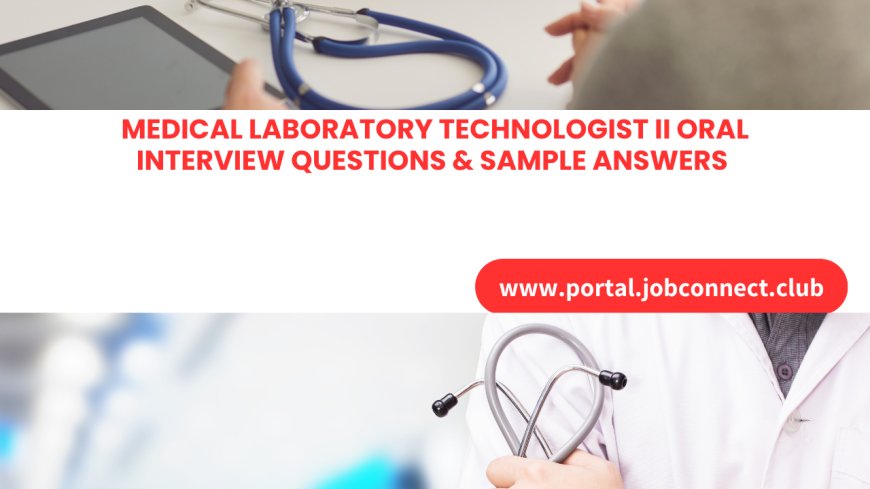Medical Laboratory Technologist II Oral Interview Questions & Sample Answers
Prepare confidently for your Medical Laboratory Technologist II interview with this comprehensive list of common oral interview questions and sample answers. Topics cover lab techniques, safety, disease transmission, and professional experience to help you succeed in 2025.

Medical Laboratory Technologist II Oral Interview Questions & Sample Answers
1. Explain your educational and professional background.
Answer:
"I completed my Bachelor’s degree in Medical Laboratory Science from [University]. During my studies, I gained practical skills in microbiology, hematology, and clinical chemistry. I completed internships at [Hospital/Laboratory], where I developed competencies in sample collection, analysis, and result reporting."
2. Name five filarial worms.
Answer:
-
Wuchereria bancrofti
-
Brugia malayi
-
Brugia timori
-
Mansonella perstans
-
Loa loa
3. List five infections transmissible through blood transfusion.
Answer:
-
HIV (Human Immunodeficiency Virus)
-
Hepatitis B Virus (HBV)
-
Hepatitis C Virus (HCV)
-
Syphilis (Treponema pallidum)
-
Malaria (Plasmodium species)
4. What are the effects of misdiagnosis? (List five)
Answer:
-
Delayed appropriate treatment
-
Worsening of patient condition
-
Increased healthcare costs
-
Psychological impact on patient and family
-
Risk of adverse drug reactions from wrong treatment
5. What materials and reagents are used in blood grouping (tile/tube method)?
Answer:
-
Anti-A serum
-
Anti-B serum
-
Anti-D (Rh) serum
-
Normal saline
-
Patient’s blood sample (red cells and serum)
6. What information is present on a patient request form?
Answer:
-
Patient’s full name and ID
-
Age and sex
-
Clinical history and diagnosis
-
Tests requested
-
Date and signature of requesting clinician
7. What details are recorded in a culture media preparation logbook?
Answer:
-
Date of preparation
-
Type of media prepared
-
Batch/lot number
-
Expiry date
-
Name/signature of the preparer
8. Explain the principle of aseptic technique in the laboratory.
Answer:
"Aseptic technique prevents contamination of samples and reagents by microorganisms, ensuring accurate test results and protecting lab personnel from infection."
9. What personal protective equipment (PPE) is essential in a laboratory?
Answer:
-
Lab coat
-
Gloves
-
Face mask or shield
-
Safety goggles
-
Closed footwear
10. Describe how you would handle a biohazard spill.
Answer:
"I would immediately inform the laboratory supervisor, put on appropriate PPE, contain the spill using disinfectant, clean and disinfect the area thoroughly, and dispose of waste according to biohazard protocols."
11. What is quality control in laboratory testing?
Answer:
"Quality control involves regular checks using control samples to ensure test accuracy, precision, and reliability."
12. How do you maintain equipment calibration?
Answer:
"By following manufacturer instructions, performing routine checks, documenting results, and scheduling regular maintenance."
13. Name five common laboratory safety precautions.
Answer:
-
Proper labeling of reagents
-
Safe disposal of sharps
-
Avoid eating/drinking in the lab
-
Hand hygiene before and after tests
-
Proper storage of chemicals
14. Explain the process of histological sample processing.
Answer:
"Tissue samples are fixed, dehydrated, cleared, embedded in paraffin, sectioned using a microtome, mounted on slides, stained, and examined under a microscope."
15. What is the role of immunoglobulins in the immune system?
Answer:
"Immunoglobulins (antibodies) recognize and neutralize pathogens, activate complement pathways, and facilitate phagocytosis."
16. How do you handle discrepancies in laboratory test results?
Answer:
"Repeat the test, review the sample quality, check for equipment errors, consult colleagues, and report findings for corrective action."
17. What is the significance of the cold chain in sample transportation?
Answer:
"Maintaining the cold chain preserves sample integrity and prevents degradation of temperature-sensitive analytes."
18. How do you ensure confidentiality in handling patient data?
Answer:
"By limiting access to authorized personnel, securing physical and electronic records, and following ethical guidelines."
19. What steps do you take in case of accidental exposure to infectious materials?
Answer:
"Immediately wash the exposed area, report the incident, seek medical evaluation, and follow post-exposure prophylaxis protocols."
20. Why is continuous professional development important in laboratory science?
Answer:
"To keep updated with new technologies, improve skills, comply with regulatory standards, and provide the best patient care."